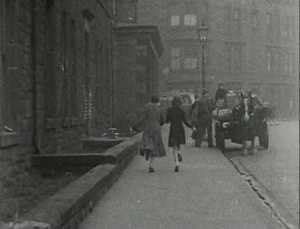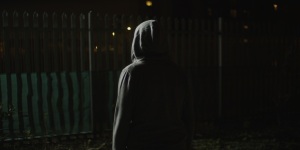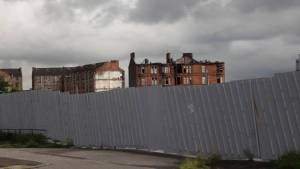The Singing Street and The Street
2pm, Saturday 10 January 2015
Nigel McIsaac, Raymond Townsend and James T. Ritchie, The Singing Street (1951)
18m; Courtesy of the Scottish Screen Archive
A collection of children’s street games filmed in the streets of Edinburgh’s Old Town accompanied by traditional children’s songs. The film was made by teachers at Norton Park School, Edinburgh, with the “Whistling” on the soundtrack by poet Norman MacCaig. “Their progress is followed along an ideal thoroughfare. In songs where ancient ritual, myth, the mountain and the rose, mingle with taxis, telephones and powder-puffs. Old rhymes rarely dying – something new always appearing. No-one asks “What does this mean?” The world’s accepted, poetry’s kept alive. Favourite topic, love and death. Not meant for education or entertainment but belonging to the art of play. Shot in six Easter days of boisterous weather, the cast, mostly girls, numbering sixty.” – Publicity leaflet

The Singing Street, 1951, courtesy of the Scottish Screen Archive
Jef Cornelis, The Street (1972)
42m; Courtesy of Argos, Centre for Art and Media, Brussels.
There is not much more left of the street than – to use a term by Le Corbusier – a machine of movement, equipped to make traffic run smoothly. The street in its original and spontaneous form, as a breeding ground for new life, is restrained. The efficiency controlling the traffic grid does not merely affect the existing living area, but also the form and pattern of new living. Residential areas have turned into traffic zones, inhabitants are pushed back into their homes. The function of the street, of the home and the working environment is marked off – there are no in-between spaces left, nothing but trajectories. In sound and image, Jef Cornelis evokes, after a scenario by Geert Bekaert, the deterioration of the street, once public, into a fragment of an unnatural, ruthless production system.
This film was made on the occasion and as an extension of the exhibition ‘De Straat. Vorm van samenleven’ (‘The Street. A Way of Living Together’) at the van Abbemuseum in Eindhoven (1972). As a result the exhibition was not confined to the walls of the museum, it was also extended to the television network. Television, in its turn, was involved in an actual social process.
The Dilapidated Dwelling
2pm, Saturday 17 January 2015
Patrick Keiller, The Dilapidated Dwelling, 2000
78m; Courtesy of Lux, London and the artist

Patrick Keiller, The Dilapidated Dwelling (2000) © the artist
The Dilapidated Dwelling is an examination of the predicament of domestic space in advanced economies, the UK in particular. A fictional researcher (with the voice of Tilda Swinton) returns from a 20-year absence in the Arctic to find that while the UK is still one of the world’s wealthiest economies, its houses, flats etc. are typically old, small, dilapidated, architecturally impoverished, energy-inefficient and, especially, extraordinarily expensive. The film asks why repeated attempts to modernise house production have not been more successful, and attempts to discover why the UK’s housing economy has become so thoroughly dystopian. It includes archive footage of Buckminster Fuller, Constant, Archigram and Walter Segal, and interviews with Martin Pawley, Saskia Sassen, Doreen Massey, Cedric Price and others.” – Patrick Keiller, October 2013
Moving Dublin
2pm, Saturday 24 January 2015
Cleary and Connolly, Moving Dublin (2009)
60m; courtesy of the artists

Cleary and Connolly, Moving Dublin, © the artists
Is Dublin becoming a centreless and edgeless sprawl on the model of Los Angeles, following its curve of affluence but learning nothing from its mistakes? Is the poverty and alienation in Dublin’s inner city and in the western and northern suburbs part of a descending spiral of urban decay? Or will the economic affluence of a decade ago re-establish itself and eventually ‘lift all boats’ to give the nascent urban regeneration a chance to succeed? Shot in 2007, Moving Dublin explores the everyday world of movement in Dublin and its vast sprawling suburbs spreading out west from the coastal city. The film looks at how far the contemporary world of the Dublin commuter has strayed from the civic realm it constituted when Joyce wrote the Wandering Rocks chapter of Ulysses.
Missing Green, Monuments and Tame Time
2pm, Saturday 31 January 2015
Anne Maree Barry, Missing Green (2013)
14m; Courtesy of the artist

Anne Maree Barry, Missing Green © the artist
Missing Green is a poetic journey through Cork Street, Dublin 8. Narrated via interviews with former Councillor John Gallagher, architect Gerry Cahill, author and journalist Frank McDonald and sociologist Aileen O’Gorman, the viewer discovers an area in Dublin that has gradually but dramatically transformed in the last 80 years. Utilsing Situationist methodologies, Barry recreates a personal dérive through the character Girl. Her journey provides a complimentary narrative by exploring the urban environment, paying attention to the smaller details, lost objects, signage, and an allotment, increasing the viewer’s awareness of the urban landscape of which the narrators speak. This hybrid film creates a dialogue that reflects on a historic area in Dublin, whilst situated in the present.
Stina Wirfelt, Monuments (2008)
7m; Courtesy of the artist
Comprising a series of photographs shot by the artist, Monuments documents a series of truncated, unfinished roads and abandoned highway ramps around Glasgow. In the fictional city of Metropolis, the deadpan voiceover describes these unused thoroughfares as remnants of ‘…a fallen paradise that remained standing – a constant reminder of what could have been’. Wirfelt casts the towering yet destitute landmarks as referents to an increasingly forgotten, or perhaps more succinctly, criticised modernist ideal, prevalent reminders of the New Towns that were never built and neighbourhoods that were not raised. The narration is cringingly sincere, however. Monuments is motivated by straightforward interplay between the dialogue and visual clues in the photographs. This approach enables a functional deceit; the viewer is encouraged to believe the loosely woven audio-diary and its historical inaccuracies about the area portrayed.
Stina Wirfelt, Tame Time (2010)
9m; Courtesy of the artist

Stina Wirfelt, Tame Time © the artist
Tame Time looks at the area of Dalmarnock, which was later transformed to house several of the sporting events and the athletes’ village during the Commonwealth Games in 2014. The fictional story is told from the perspective of a woman who regularly walks her dog in the area, an activity that makes her think about the past, the present and the future. Rather than exploring the history of the area, the video is about a person’s everyday relationship to a space and how it relates to her memory. Tame Time was commissioned by the Centre for Contemporary Art in Glasgow to commemorate the handover of the Commonwealth Games from Delhi to Glasgow in October 2010.






